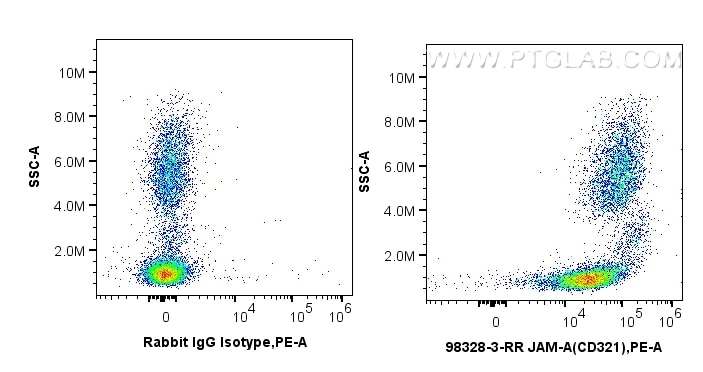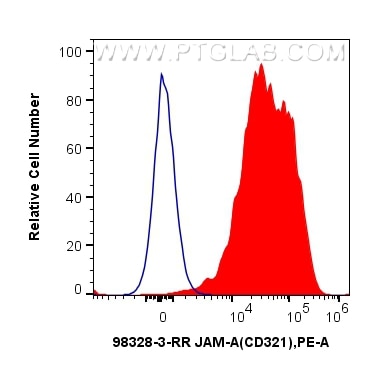Tested Applications
| Positive FC detected in | human peripheral blood leukocytes |
Recommended dilution
| Application | Dilution |
|---|---|
| Flow Cytometry (FC) | FC : 0.25 ug per 10^6 cells in 100 μl suspension |
| This reagent has been tested for flow cytometric analysis. It is recommended that this reagent should be titrated in each testing system to obtain optimal results. | |
| Sample-dependent, Check data in validation data gallery. | |
Product Information
98328-3-RR targets JAM-A/CD321 in FC applications and shows reactivity with human samples.
| Tested Reactivity | human |
| Host / Isotype | Rabbit / IgG |
| Class | Recombinant |
| Type | Antibody |
| Immunogen |
CatNo: Eg1372 Product name: Recombinant Human JAM-A/Junctional Adhesion Molecule A protein (rFc Tag) Source: mammalian cells-derived, pHZ-KIsec-C-rFc Tag: C-rFc Domain: 28-238 aa of NM_016946.6 Sequence: SVTVHSSEPEVRIPENNPVKLSCAYSGFSSPRVEWKFDQGDTTRLVCYNNKITASYEDRVTFLPTGITFKSVTREDTGTYTCMVSEEGGNSYGEVKVKLIVLVPPSKPTVNIPSSATIGNRAVLTCSEQDGSPPSEYTWFKDGIVMPTNPKSTRAFSNSSYVLNPTTGELVFDPLSASDTGEYSCEARNGYGTPMTSNAVRMEAVERNVGV Predict reactive species |
| Full Name | F11 receptor |
| Calculated Molecular Weight | 33kDa |
| GenBank Accession Number | NM_016946.6 |
| Gene Symbol | F11R |
| Gene ID (NCBI) | 50848 |
| Conjugate | Unconjugated |
| Form | Liquid |
| Purification Method | Protein A purification |
| UNIPROT ID | Q9Y624-1 |
| Storage Buffer | PBS with 0.09% sodium azide, pH 7.3. |
| Storage Conditions | Store at 2 - 8°C. Stable for one year after shipment. |
Background Information
Junctional adhesion molecule A (JAM-A), also known as CD321 or F11 receptor (F11R), was first identified in human platelets as a 32/35 kDa protein duplex that serves as the receptor for a functional antibody that activates platelets. It seems to play a role in epithelial tight junction formation. It was also reported to function as a receptor for reovirus and a ligand for the integrin LFA1.
Protocols
| Product Specific Protocols | |
|---|---|
| FC protocol for JAM-A/CD321 antibody 98328-3-RR | Download protocol |
| Standard Protocols | |
|---|---|
| Click here to view our Standard Protocols |






